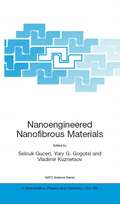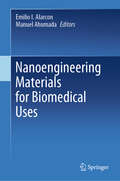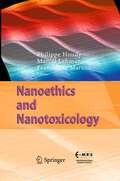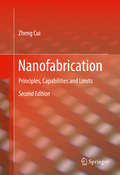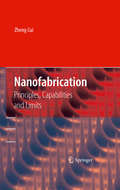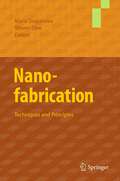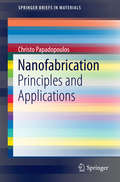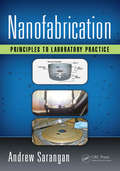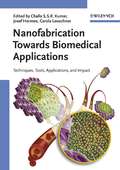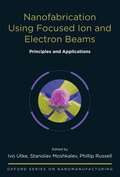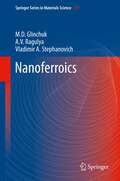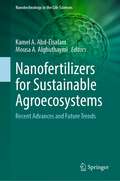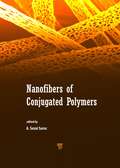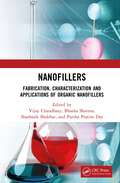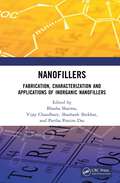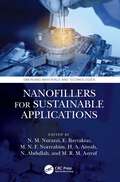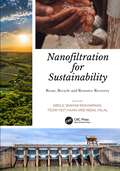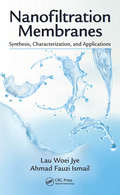- Table View
- List View
Nanoengineered Nanofibrous Materials (NATO Science Series II: Mathematics, Physics and Chemistry #169)
by Jennifer WrightThe combination of conductive polymer technology with the ability to produce nanofibres will facilitate major new developments in biotechnology and information technology, benefiting such areas as scaffolds for tissue engineering and drug delivery systems; wires, capacitors, transistors and diodes; sensor technology; biohazard protection; and energy transport, conversion and storage. The work on nanofibrous materials presented here is designed, first of all, to instruct scientists in the most advanced methods for the formation of nanofibres and nanotubes. The second section covers the physics and chemistry of nanofibres, while the third deals with computer simulation and modelling. The applications described in section 4 include biomedical applications, nanotube-based devices, electronic applications of nanotubes and nanofibres, nanofluidics, and composites. Finally, the fifth section discusses recent developments in nanomaterials, nanoparticles and nanostructures.
Nanoengineering Materials for Biomedical Uses
by Emilio I. Alarcon Manuel AhumadaThis book fills the gap between fundamental and applied research in the use of nanomaterials in biomedical applications, covering the most relevant areas, such as the fundamental concepts of the preparation of nanostructures and regulatory requirements for their safe use in biomedical devices. It also critically discusses what has been achieved in the field, and what needs to be urgently addressed and reviews the state-of-the-art medical uses of nanomaterials for treating damaged organs and tissues.Combining the expertise of clinical researchers working in the field of tissue engineering and novel materials, the book explores the main topics regarding the characterization of materials, specific organ-oriented biomaterials and their applications, as well as regulations and safety. Further, it also examines recent advances, difficulties, and clinical requirements in terms of human bone, cornea, heart, skin and the nervous system, allowing readers to gain a clear and comprehensive understanding of current nanomaterial use in biomedical applications and devices, together with the challenges and future trends.This book is a valuable tool for multidisciplinary scientists and experts interested in fundamental concepts and synthetic routes for preparing nanomaterials. It is also of interest to students and researchers involved in cross-disciplinary research in nanomaterials for clinical applications and offers practical insights for clinicians as well as engineers and materials scientists working in nanoengineering.
Nanoethics and Nanotoxicology
by Philippe Houdy Marcel Lahmani Francelyne MaranoNanobiotechnology is a fast developing field of research and application in many domains such as in medicine, pharmacy, cosmetics and agro-industry. The book addresses the lastest fundamental results on nanotoxicology and nanoethics, and the enormous range of potential applications in the fields of medical diagnostics, nanomedicine, and food and water administration. Nanoscale objects have properties leading to specific kinds of behaviour, sometimes exacerbating their chemical reactivity, physical behaviour, or potential to penetrate deeply within living organisms. Hence it is important to ensure the responsible and safe development of nanomaterials and nanotechnologies. This fourth volume in the Nanoscience series should make its mark, by presenting the state of the art in the fields of nanotoxicology and nanoethics. This is the first book to combine both scientific knowledge and ethical and social recommendations. It also presents specific policies on nanotechnologies set up by national and international authorities. This book is of interest to engineers, researchers, and graduate students.
Nanofabrication: Principles, Capabilities and Limits
by Zheng CuiThis second edition of Nanofabrication is one of the most comprehensive introductions on nanofabrication technologies and processes. A practical guide and reference, this book introduces readers to all of the developed technologies that are capable of making structures below 100nm. The principle of each technology is introduced and illustrated with minimum mathematics involved. Also analyzed are the capabilities of each technology in making sub-100nm structures, and the limits of preventing a technology from going further down the dimensional scale. This book provides readers with a toolkit that will help with any of their nanofabrication challenges.
Nanofabrication: Principles, Capabilities and Limits
by Zheng CuiThis book provides the reader with the most up-to-date information and development in the Nanofabrication area. It presents a one-stop description at the introduction level on most of the technologies that have been developed which are capable of making structures below 100nm. Principles of each technology are introduced and illustrated with minimum mathematics involved. The book serves as a practical guide and first hand reference for those working in nanostructure fabrication.
Nanofabrication: Techniques and Principles
by Maria Stepanova and Steven DewIntended to update scientists and engineers on the current state of the art in a variety of key techniques used extensively in the fabrication of structures at the nanoscale. The present work covers the essential technologies for creating sub 25 nm features lithographically, depositing layers with nanometer control, and etching patterns and structures at the nanoscale. A distinguishing feature of this book is a focus not on extension of microelectronics fabrication, but rather on techniques applicable for building NEMS, biosensors, nanomaterials, photonic crystals, and other novel devices and structures that will revolutionize society in the coming years.
Nanofabrication: Principles and Applications (SpringerBriefs in Materials)
by Christo PapadopoulosThis book provides an overview of the techniques and tools of nanostructure fabrication from state-of-the-art lithography to emerging self-assembly approaches. Top-down and bottom-up methodologies along with hybrid approaches are used to illustrate the fabrication of structures including integrated circuits, semiconductor quantum dots, metallic nanoparticles, carbon nanotubes, molecular structures, nanocomposites, arrays and superstructures. Nanofabrication applications in nanoelectronics, biotechnology, nanomechanical devices and nanophotonics will be examined. This brief will present the core concepts of nanofabrication relevant to researchers and industry in this important and rapidly evolving area.
Nanofabrication: Principles to Laboratory Practice (Optical Sciences and Applications of Light)
by Andrew SaranganThis book is designed to introduce typical cleanroom processes, techniques, and their fundamental principles. It is written for the practicing scientist or engineer, with a focus on being able to transition the information from the book to the laboratory. Basic theory such as electromagnetics and electrochemistry is described in as much depth as necessary to understand and explain the current practice and their limitations. Examples from various areas of interest will be covered, such as the fabrication of photonic devices including photo detectors, waveguides, and optical coatings, which are not commonly found in other fabrication texts.
Nanofabrication: Principles to Laboratory Practice (Optical Sciences and Applications of Light)
by Andrew SaranganThis book is designed to introduce typical cleanroom processes, techniques, and their fundamental principles. It is written for the practicing scientist or engineer, with a focus on being able to transition the information from the book to the laboratory. Basic theory such as electromagnetics and electrochemistry is described in as much depth as necessary to understand and explain the current practice and their limitations. Examples from various areas of interest will be covered, such as the fabrication of photonic devices including photo detectors, waveguides, and optical coatings, which are not commonly found in other fabrication texts.
Nanofabrication Towards Biomedical Applications: Techniques, Tools, Applications, and Impact
by Josef Hormes Carola Leuschner Challa S. S. R. KumarThis book focuses on the materials, synthetic methods, tools and techniques being developed in the nanoregime towards the life sciences -- in particular biology, biotechnology and medicine. Readers from materials science, engineering, chemistry, biology and medical backgrounds will find detailed accounts of the design and synthesis of nanomaterials and the tools and techniques involved in their production for applications in biology, biotechnology and medicine.
Nanofabrication Using Focused Ion and Electron Beams: Principles and Applications (Oxford Series in Nanomanufacturing)
by Ivo Utke Stanislav Moshkalev Phillip RussellNanofabrication Using Focused Ion and Electron Beams presents fundamentals of the interaction of focused ion and electron beams (FIB/FEB) with surfaces, as well as numerous applications of these techniques for nanofabrication involving different materials and devices. The book begins by describing the historical evolution of FIB and FEB systems, applied first for micro- and more recently for nanofabrication and prototyping, practical solutions available in the market for different applications, and current trends in development of tools and their integration in a fast growing field of nanofabrication and nanocharacterization. Limitations of the FIB/FEB techniques, especially important when nanoscale resolution is considered, as well as possible ways to overcome the experimental difficulties in creating new nanodevices and improving resolution of processing, are outlined. Chapters include tutorials describing fundamental aspects of the interaction of beams (FIB/FEB) with surfaces, nanostructures and adsorbed molecules; electron and ion beam chemistries; basic theory, design and configuration of equipment; simulations of processes; basic solutions for nanoprototyping. Emerging technologies as processing by cluster beams are also discussed. In addition, the book considers numerous applications of these techniques (milling, etching, deposition) for nanolithography, nanofabrication and characterization, involving different nanostructured materials and devices. Its main focus is on practical details of using focused ion and electron beams with gas assistance (deposition and etching) and without gas assistance (milling/cutting) for fabrication of devices from the fields of nanoelectronics, nanophotonics, nanomagnetics, functionalized scanning probe tips, nanosensors and other types of NEMS (nanoelectromechanical systems). Special attention is given to strategies designed to overcome limitations of the techniques (e.g., due to damaging produced by energetic ions interacting with matter), particularly those involving multi-step processes and multi-layer materials. Through its thorough demonstration of fundamental concepts and its presentation of a wide range of technologies developed for specific applications, this volume is ideal for researches from many different disciplines, as well as engineers and professors in nanotechnology and nanoscience.
Nanoferroics (Springer Series in Materials Science)
by M.D. Glinchuk A.V. Ragulya Vladimir A. StephanovichThis book covers the physical properties of nanosized ferroics, also called nanoferroics. Nanoferroics are an important class of ceramic materials that substitute conventional ceramic ferroics in modern electronic devices. They include ferroelectric, ferroelastic, magnetic and multiferroic nanostructured materials. The phase transitions and properties of these nanostructured ferroics are strongly affected by the geometric confinement originating from surfaces and interfaces. As a consequence, these materials exhibit a behavior different from the corresponding bulk crystalline, ceramic and powder ferroics. This monograph offers comprehensive coverage of size- and shape-dependent effects at the nanoscale; the specific properties that these materials have been shown to exhibit; the theoretical approaches that have been successful in describing the size-dependent effects observed experimentally; and the technological aspects of many chemical and physico-chemical nanofabrication methods relevant to making nanoferroic materials and composites. The book will be of interest to an audience of condensed matter physicists, material scientists and engineers, working on ferroic nanostructured materials, their fundamentals, fabrication and device applications.
Nanofertilizers for Sustainable Agroecosystems: Recent Advances and Future Trends (Nanotechnology in the Life Sciences)
by Kamel A. Abd-Elsalam Mousa A. AlghuthaymiLarge-scale chemical fertilizer application causes irreparable damage to soil structure, mineral cycles, soil microbial flora, plants, and other food chains across ecosystems, culminating in heritable mutations in future generations of consumers. A better way forward is the use of nanofertilizers to focus on macro elements (N, P, K), as switching to nanofertilizers may result in large environmental benefits by replacing the majority of these nutrients. Furthermore, the biosynthesis of nanomaterials using bacteria, algae, yeast, fungus, actinomycetes, and plants has opened up a new avenue of research in the production of inorganic nanoparticles as ecologically friendly fertilizers. Nanofertilizers should also attain increased efficiency because of a several-fold increase in the surface-to-volume ratio of nano-forms of nutrients and their suitability for foliar application, where environmental losses are further reduced. Nanostructured fertilizers can also improve nutrient use efficiency through strategies such as targeted distribution and progressive or controlled-release as they can precisely release their active molecules in response to environmental cues and biological demands. Recent research shows nanofertilizers can increase agricultural productivity by speeding up seed germination, seedling growth, photosynthetic activity, nitrogen metabolism, and carbohydrate and protein synthesis. The potential agricultural benefits of nanofertilizers, their modes of action, and the fate of nanomaterials in soil are all discussed in this book. It also covers nanofertilizer formulation and delivery, applications, uptake, translocation, and their fate in plants, as well as their impact on plant physiology and metabolism. Nutrient nanoformulation is a valuable method that has the potential to alter the agricultural sector and provide solutions to current and future concerns for sustainable and climate-sensitive crops
Nanofibers of Conjugated Polymers
by A. Sezai SaracConjugated polymer composites with high dielectric constants are being developed by the electronics industry in response to the need for power-grounded decoupling to secure the integrity of high-speed signals and to reduce electromagnetic interference. Electrically conducting polymers are materials that simultaneously possess the physical and chemical properties of organic polymers and the electronic characteristics of metals. Multifunctional micro- and nanostructures of conjugated polymers, such as of pyrrole, have received great attention in recent years because they can polymerize easily and have high conductivity and good thermal stability. They, however, have some disadvantages such as brittleness and hard processability, which can be overcome by developing their nanocomposites. Nanofiber materials with different dielectric properties can be made from conjugated polymer composites and used in the electronics industry, in sensors and batteries, for electrical stimulation to enhance nerve-regeneration process, and for constructing scaffolds for nerve tissue engineering. Electrospinning is a versatile technique that is used to produce ultrathin continuous fibers with high surface-to-volume and aspect ratios from a variety of materials, including polymers, composites, and ceramics. Conductive materials in fibrillar shape may be advantageous compared with films because of their inherent properties such as anisotropy, high surface area, and mechanical strength. They are of particular interest in electroactive composites as they can be efficiently distributed in an insulating polymer matrix to improve both electrical and mechanical properties. Combination of electrical properties with good mechanical performance is of particular interest in electroactive polymer technology. This book covers the general aspects of electrospinning and discusses the fundamental concepts that can be used to produce nanofibers with the help of mathematical models and equations. It also details the methods through which different polymeric structures can be included in conjugated polymers during electrospinning to form composites or blends of conjugated polymer nanofibers.
Nanofibers of Conjugated Polymers
by A. Sezai SaracConjugated polymer composites with high dielectric constants are being developed by the electronics industry in response to the need for power-grounded decoupling to secure the integrity of high-speed signals and to reduce electromagnetic interference. Electrically conducting polymers are materials that simultaneously possess the physical and chemical properties of organic polymers and the electronic characteristics of metals. Multifunctional micro- and nanostructures of conjugated polymers, such as of pyrrole, have received great attention in recent years because they can polymerize easily and have high conductivity and good thermal stability. They, however, have some disadvantages such as brittleness and hard processability, which can be overcome by developing their nanocomposites. Nanofiber materials with different dielectric properties can be made from conjugated polymer composites and used in the electronics industry, in sensors and batteries, for electrical stimulation to enhance nerve-regeneration process, and for constructing scaffolds for nerve tissue engineering. Electrospinning is a versatile technique that is used to produce ultrathin continuous fibers with high surface-to-volume and aspect ratios from a variety of materials, including polymers, composites, and ceramics. Conductive materials in fibrillar shape may be advantageous compared with films because of their inherent properties such as anisotropy, high surface area, and mechanical strength. They are of particular interest in electroactive composites as they can be efficiently distributed in an insulating polymer matrix to improve both electrical and mechanical properties. Combination of electrical properties with good mechanical performance is of particular interest in electroactive polymer technology. This book covers the general aspects of electrospinning and discusses the fundamental concepts that can be used to produce nanofibers with the help of mathematical models and equations. It also details the methods through which different polymeric structures can be included in conjugated polymers during electrospinning to form composites or blends of conjugated polymer nanofibers.
Nanofillers: Fabrication, Characterization and Applications of Organic Nanofillers
by Vijay Chaudhary Bhasha Sharma Shashank Shekhar Partha Pratim DasThis book explores the modifying effects of various nanofillers on mechanical and physical properties of polymer nanocomposites. Looking at the four basic aspects of processing, characterization, properties, and applications, it analyzes how their features can allow for innovative multifunction within industry. Covering design, production, and manufacture, this book focuses on meeting end-use requirements and the fabrication of materials. The importance of mindful design and the use of an appropriate synthesis method is the primary lens through which theory and practice are discussed. This volume looks at the various synthesis methods available for organic nanofillers and what characterizes them. Properties including mechanical, thermal, electrical, and tribological are thoroughly examined, along with the various computational techniques used to determine them. With important sustainable properties, nanofillers are essential to meeting the increasing demand for biodegradable and environmentally friendly materials. This book details the role nanofillers have to play in sustainability, alongside economic factors such as efficient manufacturing processes. This book will appeal to both academic and industrial engineers involved with nanofillers in a variety of industries, including automotive, aerospace, and biomedical engineering.
Nanofillers: Fabrication, Characterization and Applications of Inorganic Nanofillers
by Bhasha Sharma Vijay Chaudhary Shashank Shekhar Partha Pratim DasAnalyzing the modifying effects of various inorganic nanofillers on the mechanical properties of polymer nanocomposites, this book covers processing, characterization, properties, and applications to analyze how these materials allow for innovative multifunction. This volume looks at various synthesis methods available within inorganic nanofillers and what characterizes them, covering design, manufacturing processes, and end-user results. The chapters focus on metal oxides, energy storage, and devices, alongside polymers used for packaging. This book details the role inorganic nanofillers have to play in cost-effective manufacturing processes due to their strength and efficiency, and their subsequent relevance to low-cost yet high-performance materials. Covering topics such as corrosion resistance, wear resistance, strength, and characterization, this book is an essential companion for any engineer working with inorganic nanofillers. This book will be of interest to engineers involved with inorganic nanofillers in a variety of industries, including automotive, aerospace, and biomedical engineering.
Nanofillers: Fabrication, Characterization and Applications of Inorganic Nanofillers
Analyzing the modifying effects of various inorganic nanofillers on the mechanical properties of polymer nanocomposites, this book covers processing, characterization, properties, and applications to analyze how these materials allow for innovative multifunction. This volume looks at various synthesis methods available within inorganic nanofillers and what characterizes them, covering design, manufacturing processes, and end-user results. The chapters focus on metal oxides, energy storage, and devices, alongside polymers used for packaging. This book details the role inorganic nanofillers have to play in cost-effective manufacturing processes due to their strength and efficiency, and their subsequent relevance to low-cost yet high-performance materials. Covering topics such as corrosion resistance, wear resistance, strength, and characterization, this book is an essential companion for any engineer working with inorganic nanofillers. This book will be of interest to engineers involved with inorganic nanofillers in a variety of industries, including automotive, aerospace, and biomedical engineering.
Nanofillers: Fabrication, Characterization and Applications of Organic Nanofillers
This book explores the modifying effects of various nanofillers on mechanical and physical properties of polymer nanocomposites. Looking at the four basic aspects of processing, characterization, properties, and applications, it analyzes how their features can allow for innovative multifunction within industry. Covering design, production, and manufacture, this book focuses on meeting end-use requirements and the fabrication of materials. The importance of mindful design and the use of an appropriate synthesis method is the primary lens through which theory and practice are discussed. This volume looks at the various synthesis methods available for organic nanofillers and what characterizes them. Properties including mechanical, thermal, electrical, and tribological are thoroughly examined, along with the various computational techniques used to determine them. With important sustainable properties, nanofillers are essential to meeting the increasing demand for biodegradable and environmentally friendly materials. This book details the role nanofillers have to play in sustainability, alongside economic factors such as efficient manufacturing processes. This book will appeal to both academic and industrial engineers involved with nanofillers in a variety of industries, including automotive, aerospace, and biomedical engineering.
Nanofillers for Sustainable Applications (Emerging Materials and Technologies)
by N. M. NurazziNanofillers for Sustainable Applications provides an in-depth review of the wide-ranging applications of nanofillers. It explores both synthetic and natural nanofillers and focuses on their use as reinforcement and active fillers in composite structures. Covering various aspects of nanofillers, including synthesis methods, characteristics, properties, and compatibility, this book highlights the potential of nanofillers as functional materials for different applications and offers a collection of comparative studies to showcase their efficacy. It emphasizes sustainability, intelligent design, and high-end applications in fields such as packaging, pulp and paper, aerospace, automotive, medicine, chemical industry, biodiesel, and chemical sensors. This book is organized into several sections, covering topics such as synthetic nanomaterials, nanosafety, natural nanofillers, polymer composites, metal nanofillers, nanofillers in various industries, nanofillers in renewable energy, nanofillers in biomedical sectors, and nanofillers in automotive and aerospace industries. This book will be a useful reference for undergraduate and graduate students and academic researchers in the fields of materials science, nanomaterials, and polymer composites. Key features: • Focuses on the fabrication approaches used for nanofillers in nanocomposites. • Covers materials selection, design solutions, manufacturing techniques, and structural analysis, highlighting their potential as functional materials in different applications. • Explores the positive environmental impact and material property improvements resulting from increased composite utilization across diverse industries. • Discusses other types of nanofillers like nanocellulose, metal-based, graphene, and wood-based materials. • Includes case studies from leading industrial and academic experts.
Nanofillers for Sustainable Applications (Emerging Materials and Technologies)
Nanofillers for Sustainable Applications provides an in-depth review of the wide-ranging applications of nanofillers. It explores both synthetic and natural nanofillers and focuses on their use as reinforcement and active fillers in composite structures. Covering various aspects of nanofillers, including synthesis methods, characteristics, properties, and compatibility, this book highlights the potential of nanofillers as functional materials for different applications and offers a collection of comparative studies to showcase their efficacy. It emphasizes sustainability, intelligent design, and high-end applications in fields such as packaging, pulp and paper, aerospace, automotive, medicine, chemical industry, biodiesel, and chemical sensors. This book is organized into several sections, covering topics such as synthetic nanomaterials, nanosafety, natural nanofillers, polymer composites, metal nanofillers, nanofillers in various industries, nanofillers in renewable energy, nanofillers in biomedical sectors, and nanofillers in automotive and aerospace industries. This book will be a useful reference for undergraduate and graduate students and academic researchers in the fields of materials science, nanomaterials, and polymer composites. Key features: • Focuses on the fabrication approaches used for nanofillers in nanocomposites. • Covers materials selection, design solutions, manufacturing techniques, and structural analysis, highlighting their potential as functional materials in different applications. • Explores the positive environmental impact and material property improvements resulting from increased composite utilization across diverse industries. • Discusses other types of nanofillers like nanocellulose, metal-based, graphene, and wood-based materials. • Includes case studies from leading industrial and academic experts.
Nanofiltration for Sustainability: Reuse, Recycle and Resource Recovery
by Abdul Mohammad Teow Yeit Haan Nidal HilalThis book provides a novel exploration of the application of nanofiltration membrane technology for sustainability in various industries, situated in view of recent breakthroughs and the use of reuse, recycle and resource recovery approaches. Moving from a comprehensive discussion of nanofiltration membrane processes to case studies and real-world applications of nanofiltration technology across society, both successes and potential limitations are considered. Features: Detailed discussion of the fundamentals of nanofiltration technology The concepts of reuse, recycle and resource recovery using nanofiltration technology are explored in combination with other technologies to advance circular economy Considered across a range of industries, such as textiles, oil, gas, agriculture and pharmaceutics Written in a thoroughly detailed manner, this book is an essential guide for industry professionals interested in sustainability and working toward a circular economy. Comprehensive discussions of the fundamental processes underpinning nanofiltration technology also make this book particularly appealing to students of industrial chemistry.
Nanofiltration for Sustainability: Reuse, Recycle and Resource Recovery
by Abdul Wahab MohammadThis book provides a novel exploration of the application of nanofiltration membrane technology for sustainability in various industries, situated in view of recent breakthroughs and the use of reuse, recycle and resource recovery approaches. Moving from a comprehensive discussion of nanofiltration membrane processes to case studies and real-world applications of nanofiltration technology across society, both successes and potential limitations are considered. Features: Detailed discussion of the fundamentals of nanofiltration technology The concepts of reuse, recycle and resource recovery using nanofiltration technology are explored in combination with other technologies to advance circular economy Considered across a range of industries, such as textiles, oil, gas, agriculture and pharmaceutics Written in a thoroughly detailed manner, this book is an essential guide for industry professionals interested in sustainability and working toward a circular economy. Comprehensive discussions of the fundamental processes underpinning nanofiltration technology also make this book particularly appealing to students of industrial chemistry.
Nanofiltration Membranes: Synthesis, Characterization, and Applications
by Ahmad Fauzi Ismail Lau Woei JyeCovering fabrication, characterization, and applications nanofiltration (NF) membranes, this book provides a comprehensive overview of the development of NF membrane technology over the past decade. It uniquely covers a variety of fabrication techniques, comparing the procedures of each technique to produce polymeric membranes of different morphologies. The book also discusses advances in the materials used in thin film composite (TFC) polyamide membrane fabrication and their influences on properties with respect to structural and separation characteristics. A comprehensive review on NF characterization methods and techniques is provided, assessing physical and chemical properties and separation characteristics and stability. Technical challenges in fabricating a new generation of NF membranes are also reviewed and the possible approaches to overcome the challenges are provided. The book concludes with relevant case studies on the use of NF membranes in industrial implementation of both aqueous and nonaqueous media. Details the latest progress on the fabrication techniques of asymmetric and composite NF membranes. Discusses characterization methods used in assessing membrane physical/chemical properties, separation characteristics, and performance stability. Describes the potential of advanced materials in improving properties of polyamide selective layer as well as microporous substrate. Reviews the technical challenges in fabricating a new generation of composite membrane—thin film nanocomposite (TFN) membrane—possible approaches to overcome challenges. Offers case studies on the applications of NF membranes for both aqueous and nonaqueous media.
Nanofiltration Membranes: Synthesis, Characterization, and Applications
by Lau Woei Jye Ahmad Fauzi IsmailCovering fabrication, characterization, and applications nanofiltration (NF) membranes, this book provides a comprehensive overview of the development of NF membrane technology over the past decade. It uniquely covers a variety of fabrication techniques, comparing the procedures of each technique to produce polymeric membranes of different morphologies. The book also discusses advances in the materials used in thin film composite (TFC) polyamide membrane fabrication and their influences on properties with respect to structural and separation characteristics. A comprehensive review on NF characterization methods and techniques is provided, assessing physical and chemical properties and separation characteristics and stability. Technical challenges in fabricating a new generation of NF membranes are also reviewed and the possible approaches to overcome the challenges are provided. The book concludes with relevant case studies on the use of NF membranes in industrial implementation of both aqueous and nonaqueous media. Details the latest progress on the fabrication techniques of asymmetric and composite NF membranes. Discusses characterization methods used in assessing membrane physical/chemical properties, separation characteristics, and performance stability. Describes the potential of advanced materials in improving properties of polyamide selective layer as well as microporous substrate. Reviews the technical challenges in fabricating a new generation of composite membrane—thin film nanocomposite (TFN) membrane—possible approaches to overcome challenges. Offers case studies on the applications of NF membranes for both aqueous and nonaqueous media.
